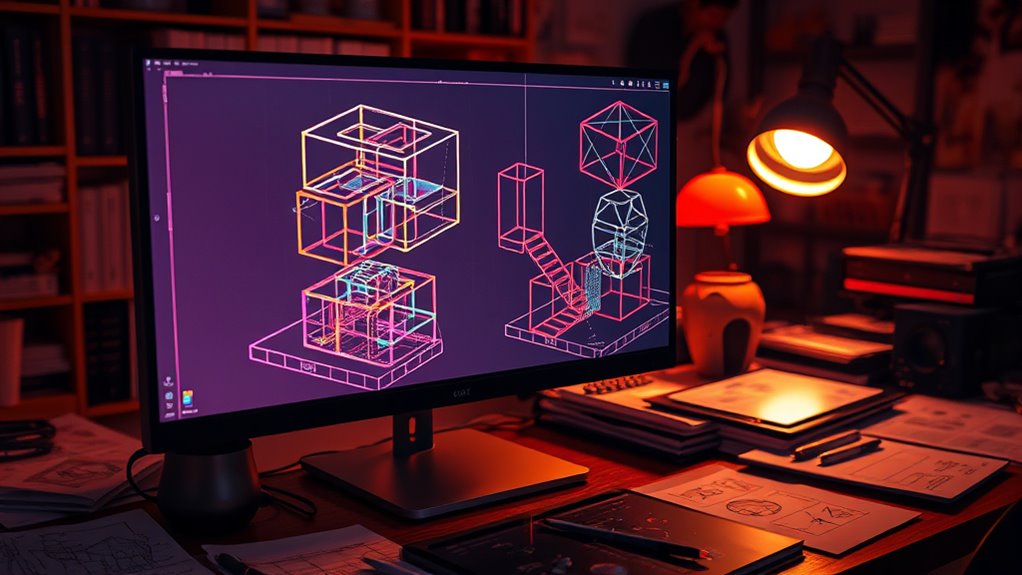In designing video games, geometry shapes how environments guide your movement and interactions. It defines pathways, obstacles, and focal points that create a seamless navigation experience. Geometry also influences puzzle design, level flow, and camera angles, enhancing immersion and clarity. By understanding how environment shapes and spatial relationships work together, you can craft more engaging worlds. Stick around to discover how game designers strategically use geometry to build mesmerizing, intuitive virtual spaces.
Key Takeaways
- Game designers use geometry to shape pathways, obstacles, and spatial layouts, guiding exploration and influencing player movement.
- Geometric design creates intuitive environments that enhance navigation, immersion, and visual coherence in video games.
- Geometry underpins procedural generation, allowing diverse, coherent worlds that adapt to player interactions in real-time.
- Designers incorporate geometric puzzles and visual cues to challenge spatial reasoning and improve gameplay clarity.
- Mathematical models and collision detection ensure realistic object interactions, maintaining immersion and seamless gameplay experiences.
The Foundations of Virtual Spaces
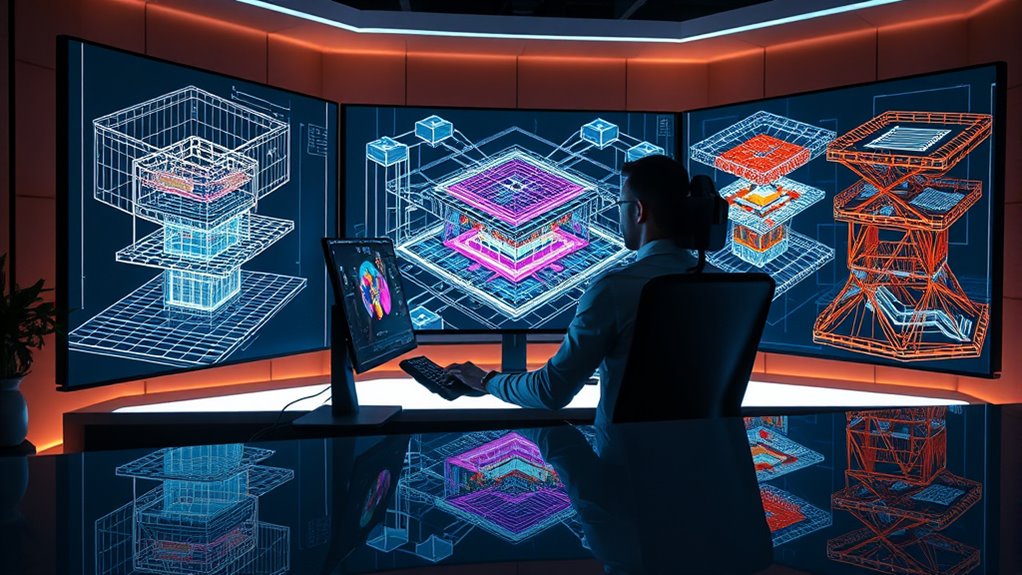
Understanding the foundations of virtual spaces is essential for designing engaging and immersive video games. You rely on procedural generation to create diverse environments quickly, making worlds feel expansive and unique every time. This technique allows you to craft complex terrains and structures without manually building each element, saving time and resources. Equally important is collision detection, which ensures that characters and objects interact realistically within the space. It prevents players from walking through walls or falling through floors, maintaining immersion and gameplay integrity. By mastering these core aspects—procedural generation for world-building and collision detection for interaction—you lay a solid groundwork. These elements shape how players explore and experience the virtual environment, setting the stage for compelling gameplay. Additionally, understanding high-quality rendering techniques enhances visual realism, making virtual spaces more believable and engaging.
How Geometry Shapes Player Movement

The geometry of a virtual environment directly influences how players move through it, shaping their experience and sense of immersion. Pathways, obstacles, and spatial layouts guide your decisions and pacing. Designers use procedural generation to create varied environments, which affects movement patterns and exploration strategies. Geometric puzzles challenge your spatial reasoning, forcing you to adapt your navigation. The design of corridors, open spaces, and verticality can encourage or restrict movement, impacting gameplay flow. Understanding local laws can help designers create environments that are both engaging and compliant with safety standards. The geometric design of spaces directs your flow, making movement intuitive or complex. Procedural generation creates unpredictable terrains, testing navigation skills. Geometric puzzles require spatial thinking to progress. Environmental shapes influence your pacing and exploration. Spatial design enhances immersion and engagement.
Designing Intuitive Environments With Geometry

Effective environment design leverages geometry to make spaces feel natural and easy to navigate. You can use procedural generation to create diverse, yet coherent, environments that guide players intuitively. Geometric shapes and patterns help define pathways, boundaries, and focal points, making exploration seamless. Incorporating geometric puzzles not only challenges players but also reinforces spatial awareness through clever use of shapes and symmetry. When designing environments, think about how geometry directs movement and attention without relying on obvious signs. Simplifying complex spaces with clear lines and familiar forms fosters a sense of comfort and discovery. By thoughtfully applying geometric principles, you craft environments that feel both inviting and logical, enhancing gameplay flow and immersion without overwhelming players. Additionally, understanding composition techniques can help you create more engaging and emotionally resonant spaces.
The Role of Perspective and Camera Angles
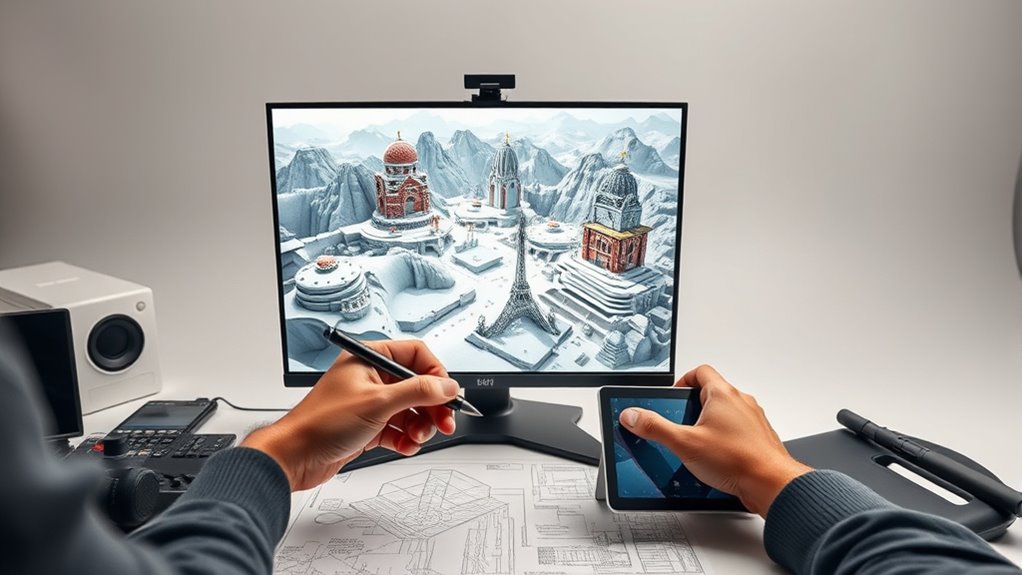
Your perspective and camera angles shape how you understand the game world and navigate it. They can sharpen your spatial awareness or make areas feel confusing. Ultimately, they profoundly impact how immersed you feel in the game experience. Understanding visual perspective is crucial in designing engaging and effective game environments.
Enhancing Spatial Awareness
Perspective and camera angles play a essential role in shaping your spatial awareness within a video game. They help you interpret the environment, navigate accurately, and anticipate obstacles. Proper angles reveal critical details, making procedural generation more intuitive by highlighting new layouts and pathways. They also improve collision detection, ensuring you don’t pass through objects or miss hazards. By adjusting perspectives, game designers can emphasize depth, scale, and spatial relationships, helping you judge distances better. Using visual cues effectively can further enhance your understanding of complex environments, making gameplay more immersive and intuitive.
Impact on Player Immersion
When camera angles and perspective are carefully crafted, they draw you deeper into the game world, enhancing your sense of presence and emotional engagement. Thoughtful viewpoint choices make procedural generation feel more believable, immersing you in environments that adapt seamlessly to your actions. Camera angles also highlight geometric puzzles, guiding your focus and making complex shapes feel intuitive rather than confusing. By controlling the visual flow, you stay connected to the game’s geometry, which heightens your emotional investment. When the perspective complements the game’s design, you experience a stronger sense of immersion, as if you’re truly steering through a living, breathing landscape. This careful interplay between perspective, procedural generation, and geometric puzzles keeps you engaged, making the experience more convincing and memorable. Moreover, understanding the role of perspective can help designers craft more compelling and emotionally resonant worlds.
Balancing Aesthetics and Functionality

Balancing aesthetics and functionality is a crucial challenge for game designers, as they endeavor to create visuals that captivate players without compromising gameplay. You need to consider how procedural generation can create diverse, visually appealing environments while maintaining clarity and usability. Applying color theory helps you choose harmonious palettes that guide players intuitively through complex scenes. Striking this balance involves prioritizing essential information without overloading visuals, ensuring clarity remains intact. Incorporating visual cues can further aid players’ understanding of game mechanics and environment navigation.
Geometry in Level Design and Layout
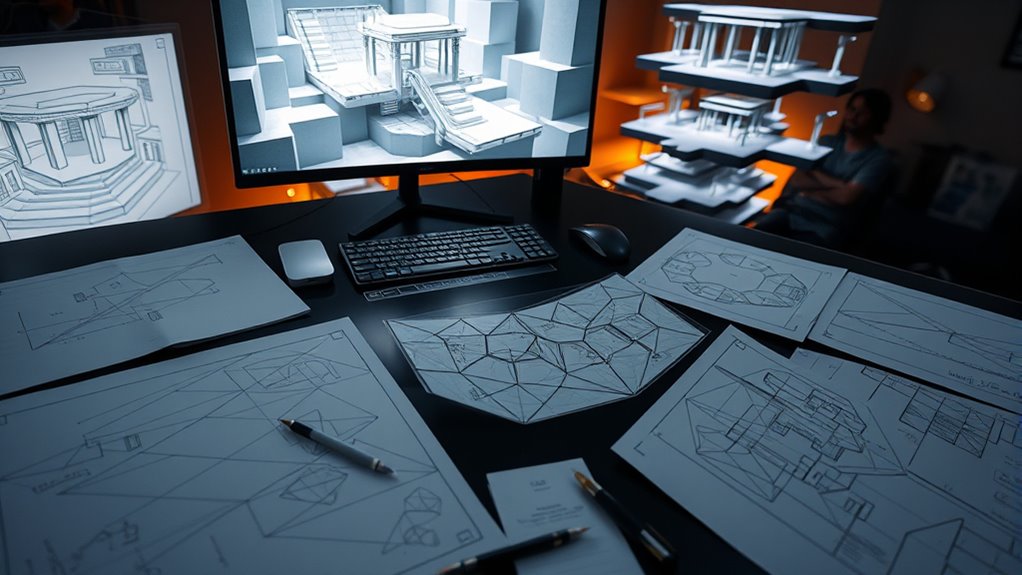
Effective level design hinges on how you shape the environment’s geometry to guide players naturally through the space. You can leverage procedural generation to create varied, dynamic layouts that keep players engaged while maintaining a cohesive flow. Geometry influences sightlines, movement paths, and focal points, subtly directing players without explicit instructions. Incorporate geometric puzzles to challenge players’ spatial reasoning, making the environment more interactive and rewarding. Well-placed geometric elements establish rhythm and balance, ensuring players feel grounded yet curious to explore further. By understanding how geometric forms and patterns interact within your levels, you craft immersive experiences that feel intuitive and satisfying, encouraging players to navigate complex environments with confidence and discovery. Attention to design consistency is also vital to maintain a seamless and believable environment.
The Mathematics Behind Physics Engines
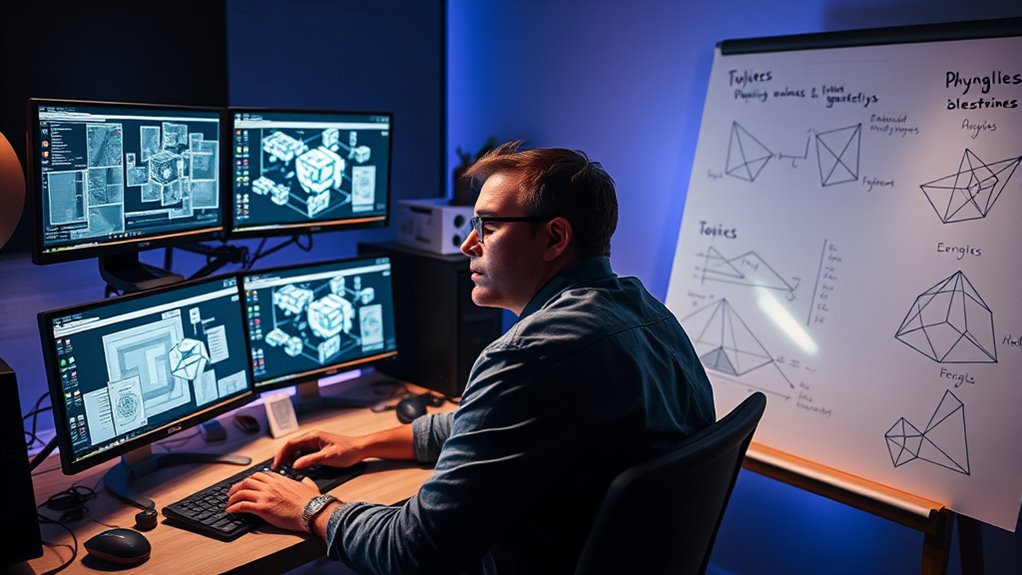
At the core of any realistic physics engine lies a set of complex mathematical principles that simulate how objects move and interact in the virtual world. These principles guarantee objects respond naturally to forces, gravity, and collisions. You’ll find that collision detection is fundamental, helping to prevent objects from passing through each other and maintaining realism. Procedural generation can dynamically create environments that physics engines must adapt to, adding complexity to simulations. To achieve accurate results, mathematic algorithms calculate velocities, accelerations, and responses in real-time.
Physics engines rely on complex math to simulate realistic object interactions and movements.
- Mathematical models enable realistic object interactions
- Collision detection algorithms prevent object overlap
- Procedural generation introduces unpredictable scenarios
- Numerical methods approximate real-world physics
- Optimization balances accuracy and performance
Creating Immersive Worlds Through Spatial Awareness
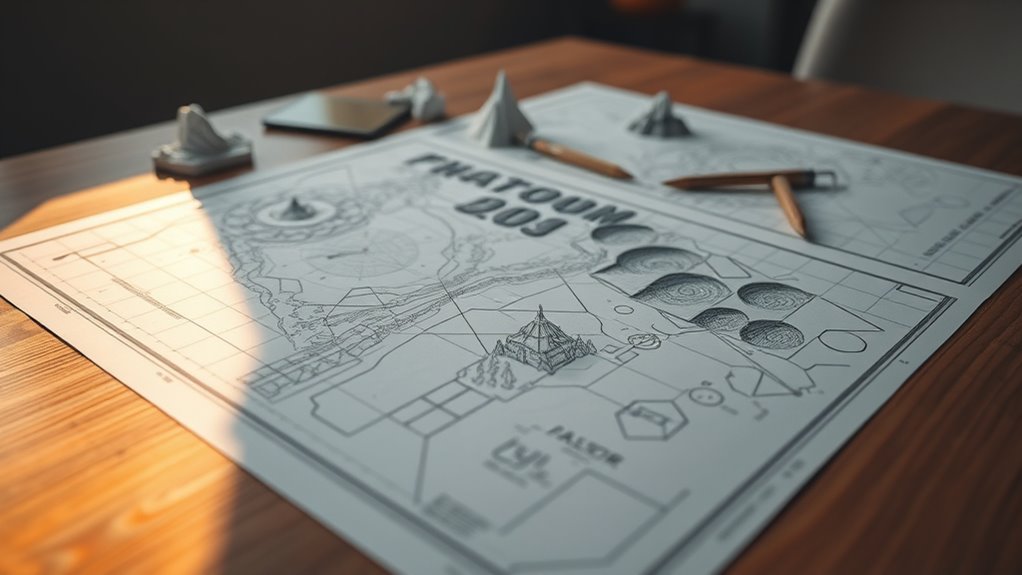
Creating immersive worlds in video games relies heavily on spatial awareness, which allows the environment to feel alive and believable. Procedural generation plays a key role by dynamically creating complex landscapes and structures that adapt to player interactions, enhancing realism. As you explore these worlds, collision detection ensures your movements feel natural, preventing characters from passing through objects or getting stuck. This system manages spatial relationships, making environments respond accurately to your actions. When designed well, these elements combine to craft a seamless experience where the world reacts intuitively to your presence. By mastering spatial awareness, you help create believable environments that draw players in, making every exploration feel authentic and engaging—transforming simple spaces into immersive worlds.
Future Trends in Game Geometry and Design

Advancements in game geometry and design are shaping how developers craft more dynamic and responsive virtual worlds. Future trends focus on integrating procedural algorithms and AI-driven layouts to create expansive, unique environments efficiently. You’ll see more games leveraging procedural algorithms to generate complex landscapes and structures on the fly, reducing development time and increasing variability. AI-driven layouts enable smarter, adaptable worlds that respond to player actions in real-time, enhancing immersion. These technologies allow designers to push creative boundaries while maintaining performance.
- Procedural algorithms generate endless content variations
- AI-driven layouts adapt environments based on player behavior
- Real-time adjustments improve immersion and replayability
- Developers optimize resources through automation
- Personalization becomes central to game experience
Frequently Asked Questions
How Does Geometry Influence Game Narrative and Storytelling?
Geometry shapes your game’s narrative architecture by guiding spatial perception, helping you understand the environment’s flow and story progression. It influences how you experience the story, creating immersive worlds that reflect characters’ journeys and themes. Clever use of spatial perception through geometry enhances emotional impact and engagement, making the narrative more compelling. Ultimately, geometry isn’t just a visual element; it’s an essential storytelling tool that shapes your understanding of the game’s world.
What Tools Do Designers Use to Visualize Complex Spatial Layouts?
Your tools for visualizing complex spatial layouts are like a superhero’s arsenal. You use procedural modeling to generate intricate environments quickly and efficiently, turning ideas into 3D worlds. Spatial analysis helps you understand how players move and interact within these spaces, ensuring a seamless experience. These tools empower you to craft immersive worlds, making the impossible seem effortless and creating game environments that captivate and challenge players.
How Are Player Feedback and Geometry Adjustments Integrated During Testing?
During testing, you analyze player behavior to identify issues with geometry or navigation. You incorporate feedback loops by observing how players interact with the environment, making adjustments based on their experiences. This iterative process guarantees the game’s geometry aligns with player expectations, enhancing immersion and flow. By continuously refining the spatial layout through real-time feedback, you create a more engaging, intuitive gaming experience that responds dynamically to player needs.
Can Geometry Principles Be Applied to Virtual Reality Environments?
Imagine stepping into a virtual reality world where every movement feels natural and intuitive. You can apply geometry principles through mathematical modeling and spatial algorithms to create immersive environments. These tools help you design realistic spaces that respond smoothly to your actions, enhancing the experience. By understanding and leveraging these principles, you guarantee VR environments are not only visually stunning but also comfortable and engaging for users.
How Does Cultural Perception Affect Geometric Design Choices in Games?
You might not realize it, but cultural perception deeply influences geometric design choices in games. Cultural symbolism shapes what shapes and patterns players find meaningful, while perception biases affect how you interpret spatial relationships. As a game designer, you can leverage these insights to create environments that resonate differently across cultures, making your game more engaging and authentic for diverse audiences. Understanding these factors helps you craft more culturally aware and immersive experiences.
Conclusion
By mastering the meticulous mathematics of game geometry, you can craft mesmerizing, cohesive, and compelling virtual worlds. Embrace evolving environments, explore endless possibilities, and elevate your designs with precision and passion. With thoughtful techniques and a keen sense of space, you’ll transform technical tools into timeless, tantalizing terrains. So, step into the sphere of spatial sophistication, and let your creative concepts continually conquer the challenges of game geometry’s grand, growing grid.
